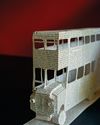Essayer OR - Gratuit
UPPER CRUST
The New Yorker
|November 27, 2023
How pizza became New Haven's calling card.

Not long ago, in line at Libby’s Italian Pastry Shop, a hundred-year old bakery in New Haven, I encountered a burly middle-aged man pacing in front of the counter in a state of distress. The cannoli, he was horrified to see, were not being filled with ricotta to order but, rather, had been pre-assembled and were now growing soggy (he was sure) in a large glass display case. He slapped a palm to his forehead. I asked him if he had come to Wooster Square, New Haven’s historically Italian neighborhood, for the pizza. He certainly had not. “I don’t buy Connecticut pizza,” he said scornfully. “I’m from the Bronx. It don’t taste right.”
I beg to differ. But, of course, I would: I was born and raised in New Haven, where pizza is also known as “apizza,” pronounced “ah-beetz,” a bit of enduring Neapolitan dialect. In the late nineteenth and early twentieth centuries, an influx of Italian immigrants, mostly from Naples, arrived to work at factories like Sargent & Co., a manufacturer of locks and hardware; in the nineteen-tens, New Haven had the highest per-capita Italian American population of any city in the U.S. Small, family-owned bakeries, many of them serving simple, inexpensive pizza made in brick ovens, proliferated in Wooster Square and beyond.
Cette histoire est tirée de l'édition November 27, 2023 de The New Yorker.
Abonnez-vous à Magzter GOLD pour accéder à des milliers d'histoires premium sélectionnées et à plus de 9 000 magazines et journaux.
Déjà abonné ? Se connecter
PLUS D'HISTOIRES DE The New Yorker

The New Yorker
THE MAGIC OF “MAFALDA”
How an Argentinean comic strip became an international phenomenon.
11 mins
July 07 - 14, 2025 (Double Issue)

The New Yorker
BY THE BOOK
What we learn from reading the fiction touted in our début issue.
13 mins
July 07 - 14, 2025 (Double Issue)

The New Yorker
THE STORY PART
Student days and a search for community.
19 mins
July 07 - 14, 2025 (Double Issue)

The New Yorker
THE SILENCE
A great silence opened up inside her. But that made it sound more dramatic than it was. It happened by degrees, creeping up slyly. And at times, in certain places and situations, it was expected and welcome—on a long walk, or when a person confessed something pitiful, or at a funeral or a party. In all those places, where once she'd had a lot to say—too much, honestly—now there was this silence and she became a far better listener. Not consciously, that was just one of the consequences. It wasn't a Zen silence or an enlightened silence or anything she'd worked to achieve. It was only a sort of blank. Once, on a mini-break, she'd spotted a sentence graffitied on a bridge in Paris: “The world is everything that is the case.” (It was written in English and stuck in her mind.) The silence felt like that: it spoke for itself. But it could also offend and disappoint others, the same way the world itself never seems enough for some people. It was no use on big family occasions, for example, or when one of her adult daughters called her name from another room, or if someone at work asked for her view on the news of the day. It could make other people feel awkward. But when she was alone with it, whenever it coincided with her own long-standing habit of looking upward into the branches of trees—then it didn't really bother her at all.
23 mins
July 07 - 14, 2025 (Double Issue)

The New Yorker
THE COMEDIAN
My father worked nights as the desk attendant at a cheap hotel downtown. It was a thankless job behind bulletproof glass, which was all he had to shield him from demented drunks and screeching prostitutes, from seven in the evening until four in the morning, the poor man.
24 mins
July 07 - 14, 2025 (Double Issue)

The New Yorker
IS IT THE PHONES?
The tantalizing power of the theory that screens are harming teens.
13 mins
July 07 - 14, 2025 (Double Issue)

The New Yorker
THE END OF THE ESSAY
What comes after A.I. has destroyed college writing?
25 mins
July 07 - 14, 2025 (Double Issue)

The New Yorker
EASY MUSIC
How Elmore Leonard perfected his style.
23 mins
July 07 - 14, 2025 (Double Issue)

The New Yorker
JUBILEE
A wooden ruler with the etched faces of Henry VIII's six wives running down the middle; ticket stubs from Hampton Court and the Chamber of Horrors, where we walked ahead of our mothers, hand in hand; a few wrappers of Dairy Milk.
34 mins
July 07 - 14, 2025 (Double Issue)

The New Yorker
PRIDE AND PROVENANCE
The Met's new Rockefeller Wing daxxles—and whispers, “Finders, keepers.”
6 mins
July 07 - 14, 2025 (Double Issue)
